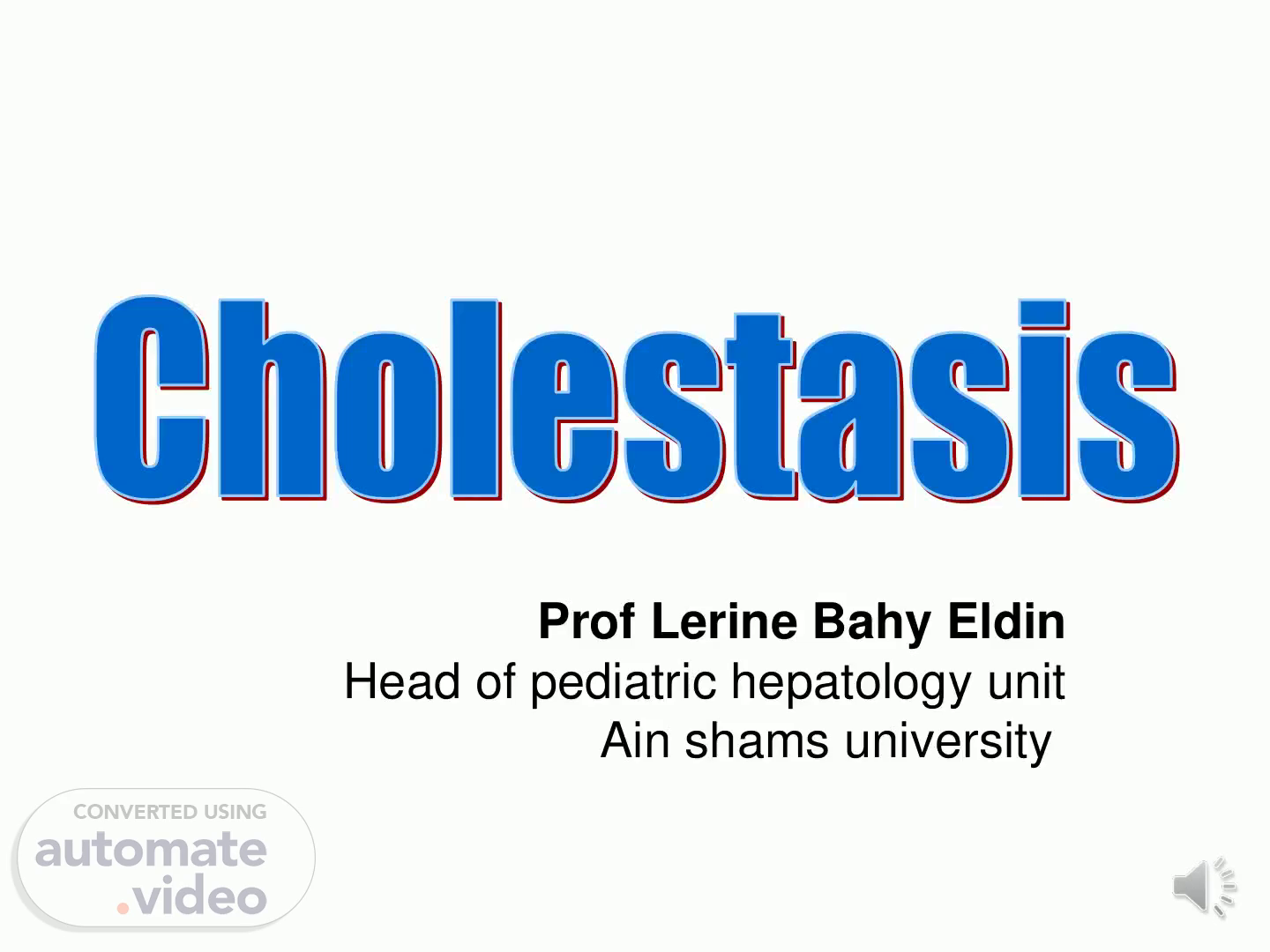Scene 1 (0s)
. . Prof Lerine Bahy Eldin. Head of pediatric hepatology unit.
Scene 2 (9s)
. . . .
Scene 3 (15s)
. . A condition in which little or no bile is secreted or the flow of bile into the.
Scene 4 (25s)
. . . Conjugated hyperbilirubinemia. . Conjugated bilirubin >.
Scene 5 (45s)
. . . . •. . Bilirubin. . metabolism. . . Biliverdin Ind Bilirubin.
Scene 6 (57s)
. . . .
Scene 7 (1m 4s)
. . . . .
Scene 8 (1m 10s)
. . . .
Scene 9 (1m 16s)
. . . Levels of bile stasis. . Hepatocyte. . :. .
Scene 10 (1m 29s)
. . . Progressive familial intrahepatic. . cholestasis.
Scene 11 (1m 45s)
. . . .
Scene 12 (1m 51s)
. . . .
Scene 13 (1m 58s)
. . . Levels of bile stasis. . Hepatocyte. . :. .
Scene 14 (2m 10s)
. . Dubin – Johnson syndrome. . .
Scene 15 (2m 17s)
. . . Bile canaliculus. . :. . hepatocyte swelling eg.
Scene 16 (2m 34s)
. . . Alagille Syndrome. . .
Scene 17 (2m 41s)
. . . Peculiar facies. . .
Scene 18 (2m 48s)
. . . Butterfly vertebrae. . .
Scene 19 (2m 56s)
. . Posterior embryotoxon. . .
Scene 20 (3m 2s)
. . . .
Scene 21 (3m 9s)
. . . Bile canaliculus. . :. . hepatocyte swelling eg.
Scene 22 (3m 25s)
. . . Extrahepatic bil system. . :. . eg EHBA,. .
Scene 23 (3m 38s)
. . EHBA. Definition. Biliary atresia is a condition in which the normal.
Scene 24 (3m 58s)
. . Types. • The fetal-embryonic form appears in the first 2 weeks.
Scene 25 (4m 20s)
. . Classification: Three main types of biliary atresia are surgicaly defined: 1 -In type I, the common bile duct is obliterated while the proximal bile.
Scene 26 (4m 49s)
. . porta hepatis lla porta hepatis gallbladder cystic duct common hepatic duct common bile duct gallbladder cystic duct common hepatic duct common bile duct bowel 11b porta hepatis bowel porta hepatis gallbladder cystic duct bowel common hepatic duct common bile duct gallbladder cystic duct bowel intra-hepatic ducts common hepatic duct common bile duct.
Scene 27 (4m 59s)
. . lla 11b. .
Scene 28 (5m 5s)
. . Clinically. Regardless of etiology, the clinical presentation of neonatal cholestasis is remarkably similar in most infants Typical symptoms include variable degrees of jaundice, dark urine, and light stools.
Scene 29 (5m 17s)
. . . .
Scene 30 (5m 23s)
. . BA is deceiving ?. In the case of biliary atresia, most infants are full-term, In most cases, acholic stools are not noted at birth but develop over the first few weeks of life and is persistent. Appetite, growth, and weight gain are always normal.
Scene 31 (5m 40s)
. . infants with biliary atresia typically show only.
Scene 32 (5m 53s)
. . Transaminases level are not markedly elevated ALP and GGT are markedly elevated Serum albumin and INR are usually normal until late stages.
Scene 33 (6m 3s)
. . US. . .
Scene 34 (6m 10s)
. . The triangular cord sign (TCS) is a specific ultrasonographic finding,.
Scene 35 (6m 20s)
. . GB. . . .
Scene 36 (6m 27s)
. . Biliary atresia can be accurately. diagnosed by ultrasonography using the findings of TCS combined with.
Scene 37 (6m 37s)
. . Do not search for IHBD. .
Scene 38 (6m 44s)
. . The presence of. triangular cord in the right and left hepatic.
Scene 39 (7m 0s)
. . HIDA scan. hepatobiliary iminodiacetic acid. scan.
Scene 40 (7m 8s)
. . . .
Scene 41 (7m 14s)
. . . .
Scene 42 (7m 21s)
. . . Liver biopsy. . .
Scene 43 (7m 28s)
. . Liver biopsy. . .
Scene 44 (7m 34s)
. . . .
Scene 45 (7m 40s)
. . This surgery is called a Kasai procedure after the Japanese surgeon who developed the surgery, Dr. Morio Kasai or called hepatoportoenterostomy This procedure is not usually curative, but ideally does buy time until the child can achieve growth and undergo liver transplantation.
Scene 46 (7m 55s)
. . . .
Scene 47 (8m 1s)
. . After kasai. Antibiotics Steroids Choleretics Fat soluble vitamins.
Scene 48 (8m 8s)
. . . other causes of cholestasis. . Metabolic. .
Scene 49 (8m 28s)
. . . .
Scene 50 (8m 34s)
. . . other causes of cholestasis. . Metabolic. .
